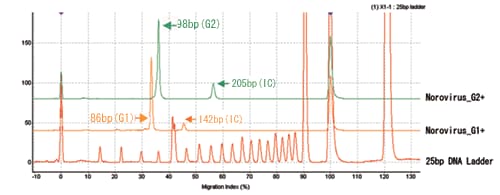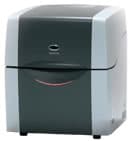Microorganism and Virus Detection|Detection of Norovirus Genes
Norovirus is the major cause of acute viral gastroenteritis. Infection can result from oysters and other seafood or from contact with the feces or vomit of an infected patient. A number of food infection cases are reported every year.
A norovirus-positive sample was analyzed using the Microchip Electrophoresis System for DNA/RNA Analysis.
Results
Genes 86 and 142 bp in size derived from norovirus G1 were detected, and genes 98 bp and 205 bp in size derived from norovirus G2 were detected.
* Norovirus has two genetic types, G1 and G2.

Microchip Electrophoresis System for DNA/RNA

DNA and RNA samples are separated by size by the electrophoresis system using a microchip so that the size of nucleic acid (DNA/RNA) samples is verified and approximately quantitated. The microchip achieves an electrophoresis system capable of speedily conducting electrophoresis separation, and a fluorescent detector ensures that analysis is performed to high sensitivity and, moreover, fully automatically.
Norovirus Detection Reagent Kit

As norovirus cannot be cultured, gene amplification is widely used for virus detection. However, as biosamples contain large amounts of enzymes that degrade genes and substances that inhibit gene amplification, it is necessary to separate the virus from the biosample and then extract and purify the genes it contains.
The Norovirus Detection Reagent Kits restrict gene-degrading enzymes and amplification inhibitors in biosamples to permit the direct amplification and detection of norovirus genes from a biosample without gene purification.


